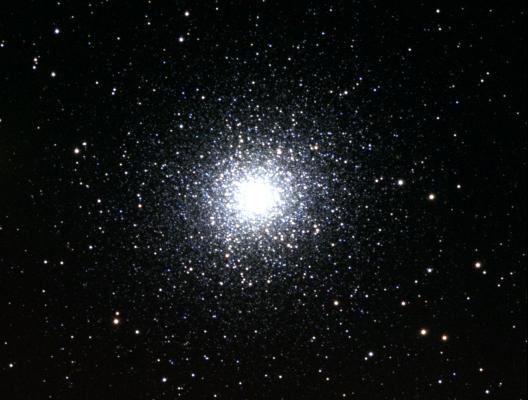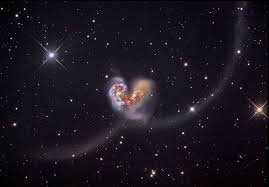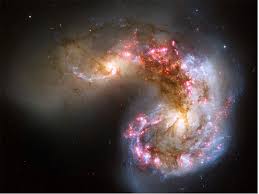User:Tohline/DissertationTopics/GCFormation
Globular Cluster Formation During Galaxy-Galaxy Collisions
|
"… Low-level star formation (e.g., in quiescent galactic disks) tends to produce few, if any, GCs. … Massive star clusters appear to form during all major star-forming events, such as those accompanying galaxy-galaxy interactions …" |

|
|---|
| | Tiled Menu | Tables of Content | Banner Video | Tohline Home Page | |
|
The manuscript identified immediately below presents an hypothesis regarding globular cluster formation that came to me as a EUREKA! moment one day (in the mid-to-late 1990s) while I was attending a Physics & Astronomy departmental colloquium at LSU. The colloquium speaker was, as I recall, someone from U. C. Berkeley with experimental space sciences expertise; and the topic of the colloquium was Galactic cosmic rays. Here are a set of critical ideas that, as a result of my prior studies, were stored in the back of my mind as I entered this colloquium:
- A key obstacle to understanding how globular clusters form is competing time scales.
- As a star cluster forms from a gas cloud, it can remain gravitationally bound (as globular clusters are) only if the star formation rate is sufficiently high that roughly half of the mass of the cloud is converted into stars within one sound-crossing time (of the cloud).
- Giant molecular clouds (GMCs) have approximately the same mass as globular clusters, and their clumpy structures appear to present conditions that are suitable for star formation. But stars form too slowly in these molecular clouds; the typical outcome is the formation of "open," rather than "bound," clusters.
- A preponderance of evidence suggests that molecular clouds are supported against collapse — resulting in a relatively slow star formation rate — by an interstellar magnetic field that threads through the clouds.
For over a decade (prior to the aforementioned departmental colloquium) I had tossed around in my mind the following conjecture: If, via some miracle, the magnetic field were to instantly disappear from one of our Galaxy's molecular clouds, it is likely that the majority of clumps within the cloud would dynamically collapse to form stars and a bound star cluster might very well be the result. In such a (admittedly very unlikely!) situation, a GMC might transform into a globular cluster.
|
In the mid-1990s, some of the earliest, high-quality Hubble (HST) images revealed that very young, globular-size star clusters exist near the centers of colliding, "starburst" galaxies. (See, for example, NGC 3921; or NGC 4038/4039 — the so-called "Antennae Galaxies".) This indicates that galaxy-galaxy collisions produce at least one environment that is conducive to the formation of high-mass, bound star clusters. But why; or how?
As a matter of course during his presentation, the colloquium speaker reminded the audience — and me, in particular — that the dense, cold "protostellar" cores of molecular clouds are coupled to the interstellar magnetic field (only) because the gas is partially ionized by Galactic cosmic rays. Furthermore, the Galaxy's charged-particle cosmic-ray flux is highest near the mid-plane of the Galaxy's disk because the cosmic rays are trapped by the disk's relatively ordered, large-scale interstellar magnetic field. All of a sudden, it occurred to me that, if our Galaxy were to collide with another galaxy …
- Its disk and, along with it, the interstellar magnetic field would very likely become much less organized;
- Cosmic rays would no longer be well confined to the disk and — as a consequence of streaming out of the disk at relativistic speeds — the flux of cosmic rays would fairly rapidly drop within the Galaxy's molecular clouds;
- The dense, protostellar cores of molecular clouds would fairly rapidly decouple from the magnetic field — not because the field, itself, disappears, but because the cores are no longer sufficiently ionized.
EUREKA! This would create an environment highly conducive to rapid star formation, perhaps throughout an entire giant molecular cloud (GMC) complex. This would trigger a rapid burst of star formation and, perhaps, a transformation of the GMC into a massive, bound star cluster. It is this idea and accompanying reasoning that is fleshed out in the paper that I wrote in 2000 (while on sabbatical leave at Caltech) in collaboration with Nick Scoville and Andrew Strong:
- Original manuscript (submitted to The Astrophysical Journal in June, 2000): J. E. Tohline, N. Z. Scoville, & A. W. Strong (2000)
This paper was never published because the journal referee requested a more extensive demonstration of the proposed model's viability; here is a copy of that report:
- Referee Report (received August, 2000).
I considered the referee's request to be well beyond the scope and essential purpose of this paper. I remain firmly convinced that the idea has a great deal of merit. I offer the original manuscript as a foundation on which an appropriately qualified graduate student might build a more extensive demonstration of the viability of this proposed mechanism for globular cluster formation.
See Also
- K. M. Ashman & S. E. Zepf (1998), Globular Cluster Systems, (New York: Cambridge University Press).
- B. Whitmore (2000, ASP Conference Series, 197, 315), "Globular Cluster Formation in Mergers"
- W. E. Harris (2001, p. 223), Globular Cluster Systems, Saas-Fee Lectures (Berlin: Springer-Verlag)
- J. P. Brodie & J. Strader (2006, Annual Review of Astronomy & Astrophysics, 44, 193 - 267), Extragalactic Globular Clusters and Galaxy Formation.
- Slide presentation by Eve LoCastro (2009), who also cites the following:
- D. A. Forbes, J. P. Brodie, & C. J. Grillmair (1997, AJ, 113, 1652), On the Origin of Globular Clusters in Elliptical and cD Galaxies.
- R. Cen (2001, ApJ, 560, 592 598), Synchronized Formation of Subgalactic Systems at Cosmological Reionization: Origin of Halo Globular Clusters.
- E. W. Peng et al. (2008, ApJ 687, 197‐224), The ACS Virgo Cluster Survey. XV. The Formation Efficiencies of Globular Clusters in Early‐Type Galaxies: The Effects of Mass and Environment.

|
|---|
|
© 2014 - 2021 by Joel E. Tohline |


